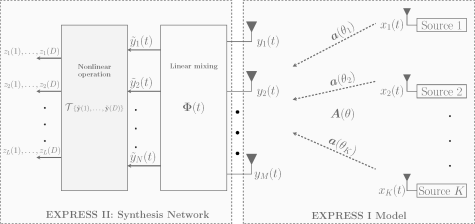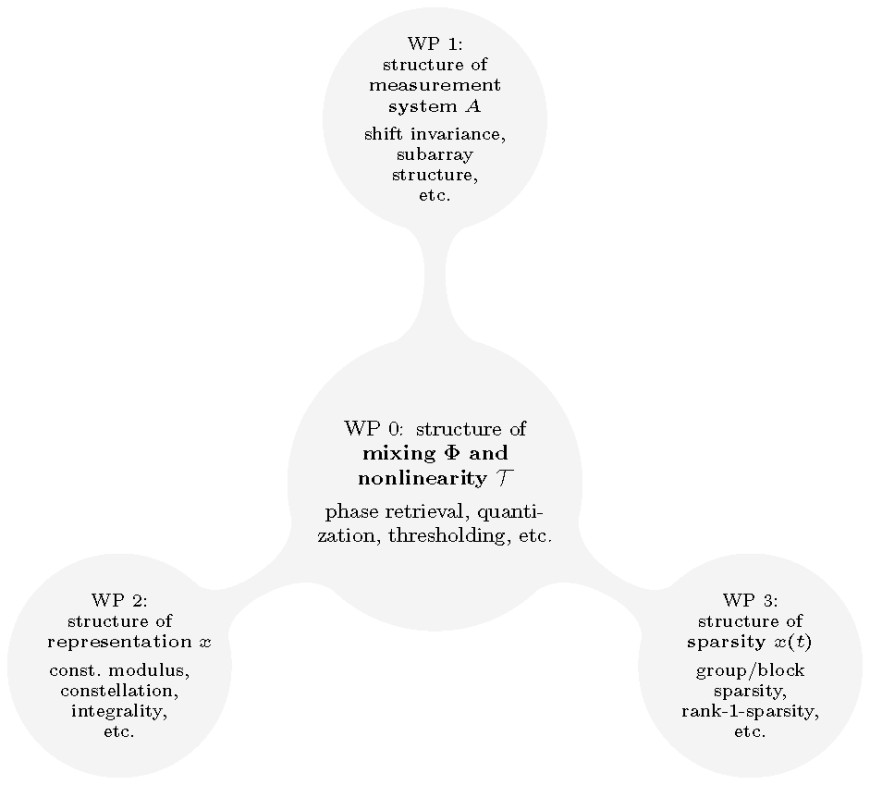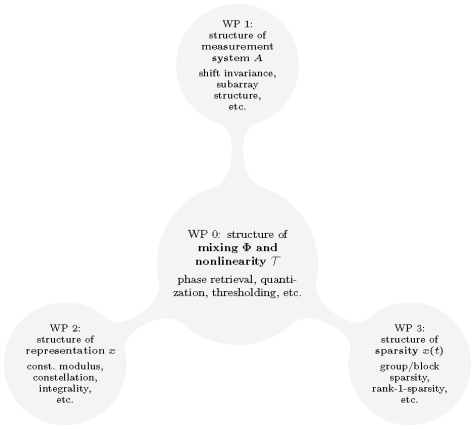Exploiting structure in compressed sensing using side constraints – from analysis to system design (EXPRESS II)
The project is funded within the framework of the DFG program of emphasis “Compressed Sensing in Information Processing” (CoSIP). (see Poster) (opens in new tab)
Summary
Compressed sensing is a signal processing technique for efficient acquisition and reconstruction of signals based on an underlying model sparsity, which allows to recover the signal of interest from far fewer samples than required by traditional acquisition systems operating at Nyquist rate. In EXPRESS I, we have investigated the impact of side constraints on the measurement system and the signal representation. In particular, we have considered sparse reconstruction techniques for multidimensional frequency estimation and studied how structure in conventional sensing systems or sensor arrays, the source signal of interest, and the temporal variation in multi snapshot scenarios can be exploited to improve reconstruction guarantees and estimation performance. While the focus of EXPRESS I was on the analysis of sparse signals under various types of structure, the focus of EXPRESS II (Exploiting structure in compressed sensing using side constraints: From analysis to system design – Funding phase II) will shift towards the design of analog-digital acquisition systems for multidimensional frequency estimation under various types of structure.
Multidimensional frequency estimation is a fundamental problem in a large variety of applications including spectrography, tomography, MIMO communications, source localization, etc. Modern sensing systems for multidimensional frequency estimation, e.g., in “Massive MIMO” or large-scale sensor array applications, consist of a massive assembly of wideband sensors to meet the high throughput and high resolution requirements of the applications. In order to keep hardware costs in these large scale systems at a reasonable scale while retaining high performance, new mixed analog-digital sensing system designs are required to reduce the number and the sampling rates of the analog-to-digital converters as well as the quality requirements (e.g., w.r.t. linearity, dynamic range, . . . ) of the hardware components.
Within EXPRESS II, we will therefore study the system design for compressed sensing analog-digital data acquisition involving linear multidimensional analog mixing networks, nonlinear transformations and low rate / low resolution sampling units while taking the various types of structure from EXPRESS I into account. We will devise strategies for the linear and nonlinear mixing networks that exploit the sparsity of the signal model as well as particular prior information regarding the structure of the array geometry or the signal of interest to use the resources of the sampling unit (number of bits per time unit) most efficiently. The general concept of linear/nonlinear mixing networks is illustrated in Fig 1.
Unlike the sparse linear signal model in EXPRESS I (see the linear network on the righthand side of Fig. 1), we consider general flexible and cost efficient configurable data acquisition systems that emerge in modern mixed analog/digital hardware architectures, where part of the signal processing and information compression is carried out in configurable analog/digital hardware devices that can be synthesized generally on a slightly larger time scale than the clock speed of the subsequent sampling unit and digital processing network. This may involve tunable filters, combiners and phase shifters, electronically steerable parasitic antenna radiator array (ESPAR), fast switching networks, configurable non-linear hardware components like power amplifiers, subband power measurement devices, to mention just a few. Such configurable hardware architectures are particularly suitable for large scale (massive) multichannel acquisition systems, where conventional sampling schemes based on Nyquist sampling become unaffordable (see the synthesis network on the left-hand side of Fig. 1). Under the assumption of sparsity and considering several forms of signal structures (as outlined above) lower dimensional or compressed
signals are generated, e.g., cost efficiently in the analog domain. This involves simple analog operations like linear combination of channels or spatial/temporal filtering. The outputs of this linear mixing network are then stored and further processed in the digital baseband. The fundamental question to address in WP 0 of EXPRESS II is how to synthesize the analog mixing network (dimension of the mixing networks, filter weights, etc.), and how to choose and parameterize the nonlinear operations, e.g., for thresholding or quantization to sense the signal most efficiently in terms of hardware cost and storage bandwidth given the prior knowledge that the signal exhibits sparsity in some domain.
The general objectives of EXPRESS II are illustrated in the mind map of Fig. 2. We will explore how knowledge of particular structure in the array geometry (WP 1), the source signal (WP 2), and the temporal signature of the signal (WP 3), which have been studied in EXPRESS I in the context of standard linear acquisition systems, can be used to improve the sparse reconstruction in generalized compressed sensing networks involving linear and nonlinear mixtures (WP 0). In EXPRESS II, we will
1. devise strategies to design, configure and dimension the analog/digital synthesis network for data acquisition under particular sparse models with structure,
2. develop powerful optimization algorithms for sparse signal reconstruction under structure,
3. provide customized solutions for a rich variety of modern applications and estimation problems in the context of large scale multidimensional multi-sensor signal processing and communication networks, where cost efficient data acquisition is of utmost interest.






